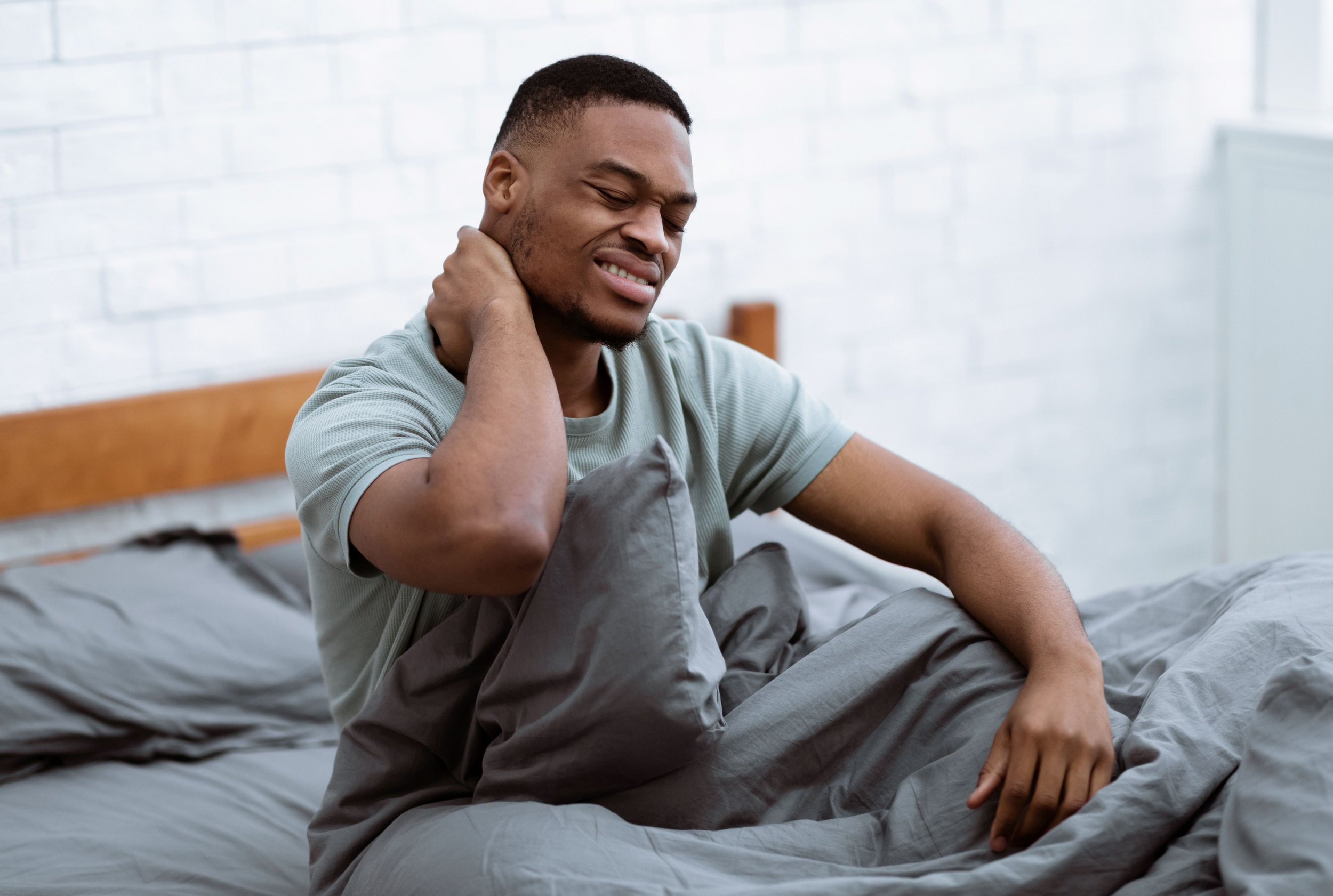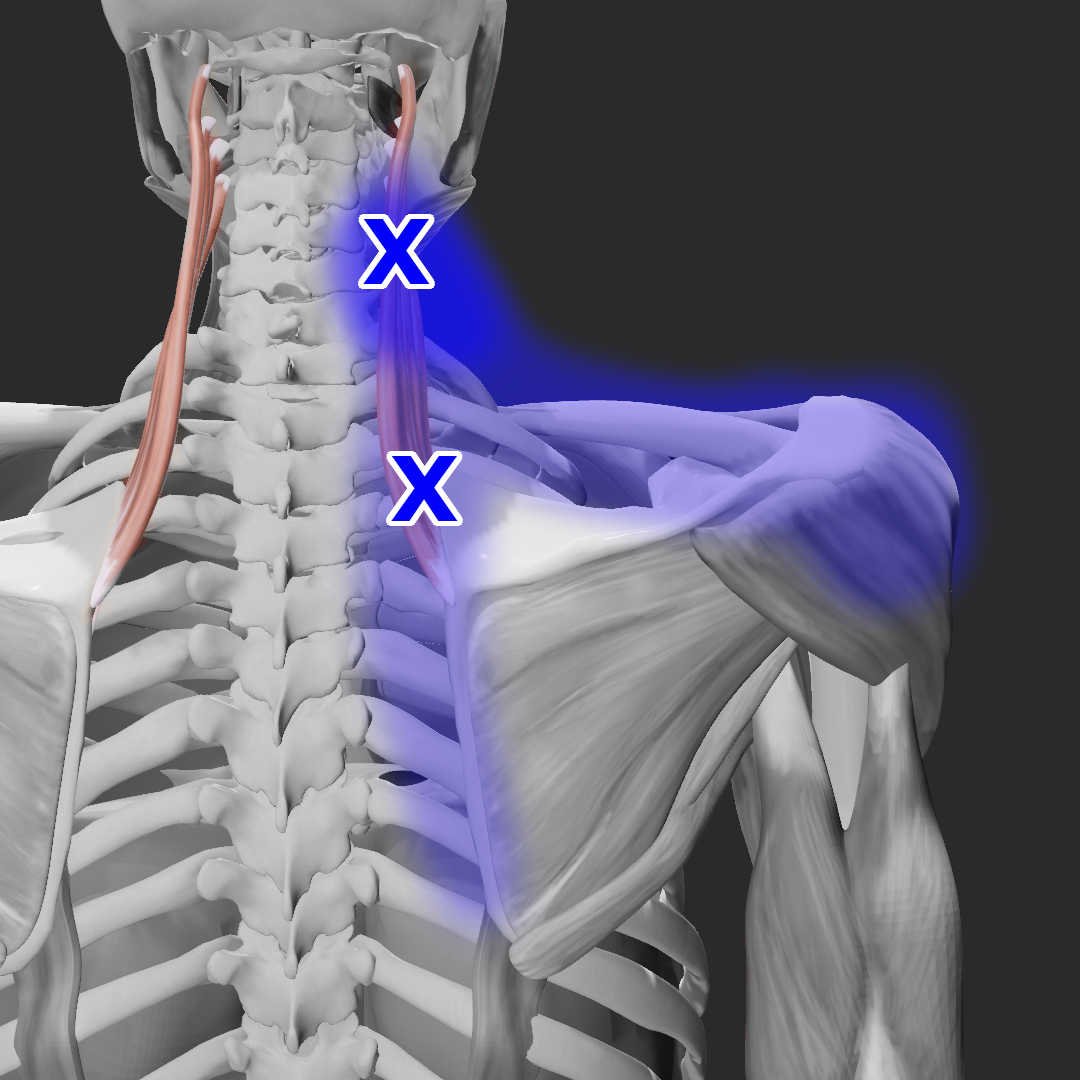Acupuncture for Levator Scapulae Pain
A person with a stiff neck when waking up
How to Get Relief from Levator Scapulae Muscle Pain?
Do you experience pain in the back of your shoulder, neck, or upper back? Are you struggling with a stiff neck or problems holding your arms up? If so, you might be dealing with levator scapulae muscle pain. Read on to learn about levator scapulae trigger points and why you should consider treating them with acupuncture and dry needling.
What is the Levator Scapulae Muscle?
The levator scapulae muscle is located in the upper back and neck region, running from the top of the cervical spine to the scapula. This muscle is responsible for several key movements, such as:
Elevation of the scapula, allowing you to lift your shoulders towards your ears.
Upward rotation of the scapula, helping the inferior angle move upwards.
Lateral flexion of the neck, enabling you to bend your head to the side.
The levator scapulae muscle is active during many everyday activities like lifting, reaching, and carrying objects. It also plays a role in sports that involve overhead movements, such as swimming and tennis.
The levator scapulae's main function is to elevate the scapula. It works with the trapezius and rhomboid muscles to do so. The levator scapulae, in combination with the lower fibers of the trapezius, latissimus dorsi, rhomboids, pectoralis major and minor, also rotates the scapula downwards, lowering the glenoid cavity. The levator scapulae muscle also aids in extending the neck, same side rotation, and side bending of the neck. It is an important muscle when it comes to head posture and can be affected by excessive forward bending of the neck.
Common Indications for Levator Scapulae Trigger Points
Back of Shoulder Pain
Mid-Thoracic Back Pain
Upper Thoracic Back Pain
Back of Neck Pain
Stiff Neck
Problems Holding Arms Up (e.g., when folding sheets)
Trigger points in the levator muscle typically cause a stiff neck, restricted range of motion in the neck, and pain in the back and side of the neck. Additionally there can be pain in the back of the shoulder, upper or mid back, along with problems holding the arms up since the muscle raises the shoulder blade.
Levator Scapulae Muscle Actions
Unilaterally:
Elevate the scapula
Downwardly rotate the scapula
Laterally flex the head and neck
Rotate the head and neck to the same side
Bilaterally:
Extend the head and neck
Signs and Symptoms of Levator Scapulae Trigger Points
"Stiff Neck"
Pain at the angle of the neck
Torticollis
Inability to turn the head fully to either the same or opposite side
Levator Scapulae Trigger Points
Levator Scapulae Trigger Point Locations
The two trigger points in the levator scapulae muscle refer pain to the posterior shoulder and neck, as well as the medial border of the scapula.
Perpetuating Factors for Levator Scapulae Pain
Postural stress, such as turning your head to face a computer or holding a phone to your ear
Sleeping with the neck tilted, like on an airplane or using a poor pillow
Psychological stress
Using a cane that is too long
Infections that cause coughing
Differential Diagnosis for Levator Scapulae Trigger Points
Splenius cervicis TrPs
SCM TrPs
Scapulocostal dysfunction
Associated Trigger Points to Levator Scapulae Pain
It is important to assess related trigger points when treating levator scapulae pain.
Levator Scapulae Synergists and Antagonists
Synergists:
Scapular elevation: Trapezius and serratus
Scapular rotation: Latissimus dorsi
Antagonists:
Scapular elevation: Trapezius, serratus anterior
Scapular rotation: Latissimus dorsi, serratus anterior
Levator Scapulae Origin and Insertion
Origin:
Transverse processes of the 1st to 4th cervical vertebrae
Insertion:
Medial border of the scapula, between the superior angle and the superior portion of the spine of the scapula
The levator scapulae muscle originates in top half of the cervical spine and connects to the upper medial corner of the shoulder blade so it works to lift the shoulder blade, turn the neck, side bend the neck, and also can extend the neck and rotate the scapula downwards.
Treatment for Levator Scapulae Pain
Acupuncture and dry needling stand out as highly effective treatments for trigger points in the levator scapulae muscle, backed by research and clinical studies. In addition to these methods, a comprehensive treatment plan may also include targeted stretching and strengthening exercises, myofascial release techniques, physical therapy to relieve tension and discomfort in the muscle.
The levator scapulae muscle can also be involved in two conditions, levator scapulae syndrome, and snapping scapula syndrome. Releasing trigger points in the muscle can help with symptoms of both.
A 2023 study showed that dry needling offers effective levator scapulae treatment to reduce pain and increase pressure pain threshold in patients both 48 hours and 1 week after treatment. The study also found that dry needling outperformed ischemic compression, another treatment technique for trigger points, both 48 hours and 1 week following treatment.
Levator Scapulae Syndrome
Levator Scapulae Syndrome is a condition characterized by tenderness over the upper medial angle of the scapula, often exacerbated by movements that stretch the muscle. Trigger points in the levator scapulae muscle are frequently responsible for symptoms like a "stiff neck" and limited rotation. According to a study by Menachem et al. (1993), this condition is often unrecognized but well-documented, and effective treatment modalities include physical therapy and local corticosteroid injections. Another study by Estwanik (1989) also emphasized the role of levator scapulae pathology in this syndrome.
Snapping Scapula Syndrome
Snapping Scapula Syndrome, often called "washboard syndrome," is a condition that causes a painful grinding or snapping sensation in the shoulder blade area. This issue is often linked to chronic stress, overuse, or muscle imbalances. Trigger points and shortening in the levator scapulae muscle can contribute to this condition by causing muscle imbalances and altering the normal movement of the shoulder blade. This can lead to painful friction or "snapping" between the shoulder blade and the ribcage, especially in people who engage in repetitive or load-bearing activities, such as military personnel. de Carvalho et al. (2019), Patzkowski et al. (2014).
Treatment using acupuncture and dry needling to release trigger points and levator scapulae tightness can help to improve these issues.
Final Thoughts
To minimize discomfort and strain in the levator scapulae, it's crucial to adopt ergonomic practices, such as proper posture and balanced weight distribution across both shoulders. Periodic rest intervals during activities that involve repetitive motion can also be beneficial. For those dealing with ongoing pain or tension in the levator scapulae, acupuncture and dry needling offer promising avenues for relief and recovery.
Over to you
If you liked this article, please share with friends and family who may be suffering with a stiff neck or levator scapulae pain.
Sources:
Travell, J. G., Simons, D. G. (1993). Myofascial pain and dysfunction: The trigger point manual. London: Lippincott Williams & Wilkins.
Biel, A., & Dorn, R. (2010). Trail guide to the body: A hands-on guide to locating muscles, bones and more. Boulder, CO: Books of Dicovery.
Janda, Vladimír. “Muscle Function Testing.” (1983).
Henry JP, Munakomi S. Anatomy, Head and Neck, Levator Scapulae Muscles. [Updated 2022 Aug 30]. In: StatPearls [Internet]. Treasure Island (FL): StatPearls Publishing; 2023 Jan-. Available from: https://www.ncbi.nlm.nih.gov/books/NBK553120/
Velázquez Saornil, J.; Sánchez Milá, Z.; Campón Chekroun, A.; Barragán Casas, J.M.; Frutos Llanes, R.; Rodríguez Sanz, D. Effectiveness of Dry Needling and Ischaemic Trigger Point Compression of the Levator Scapulae in Patients with Chronic Neck Pain: A Short-Term Randomized Clinical Trial. J. Clin. Med. 2023, 12, 6136. https://doi.org/10.3390/jcm12196136
Menachem A, Kaplan O, Dekel S. Levator scapulae syndrome: an anatomic-clinical study. Bull Hosp Jt Dis. 1993 Spring;53(1):21-4.
Estwanik JJ. Levator Scapulae Syndrome. Phys Sportsmed. 1989 Oct;17(10):57-68.
de Carvalho SC, Castro ADAE, Rodrigues JC, Cerqueira WS, Santos DDCB, Rosemberg LA. Snapping scapula syndrome: pictorial essay. Radiol Bras. 2019 Jul-Aug;52(4):262-267.
Patzkowski JC, Owens BD, Burns TC. Snapping scapula syndrome in the military. Clin Sports Med. 2014 Oct;33(4):757-66.
Disclaimer: This web site is intended for educational and informational purposes only. Reading this website does not constitute providing medical advice or any professional services. This information should not be used for diagnosing or treating any health issue or disease. Those seeking medical advice should consult with a licensed physician. Seek the advice of a medical doctor or other qualified health professional for any medical condition. If you think you have a medical emergency, call 911 or go to the emergency room. No acupuncturist-patient relationship is created by reading this website or using the information. Morningside Acupuncture PLLC and its employees and contributors do not make any express or implied representations with respect to the information on this site or its use.

